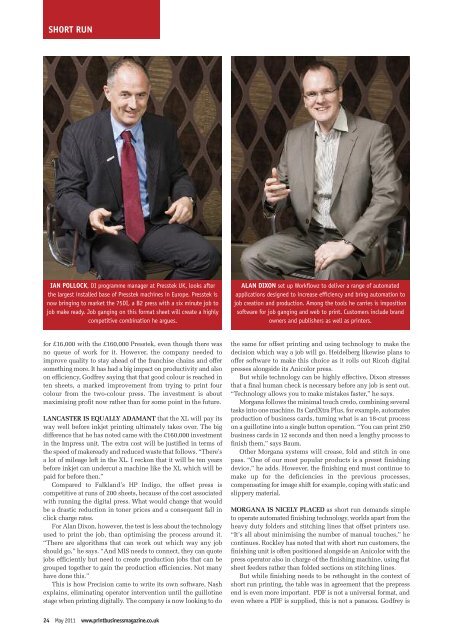The UK's favourite print show - MacMate
The UK's favourite print show - MacMate
The UK's favourite print show - MacMate
Create successful ePaper yourself
Turn your PDF publications into a flip-book with our unique Google optimized e-Paper software.
SHORT RUN<br />
IAN POLLOCK, DI programme manager at Presstek UK, looks after<br />
the largest installed base of Presstek machines in Europe. Presstek is<br />
now bringing to market the 75DI, a B2 press with a six minute job to<br />
job make ready. Job ganging on this format sheet will create a highly<br />
competitive combination he argues.<br />
for £16,000 with the £160,000 Presstek, even though there was<br />
no queue of work for it. However, the company needed to<br />
improve quality to stay ahead of the franchise chains and offer<br />
something more. It has had a big impact on productivity and also<br />
on efficiency, Godfrey saying that that good colour is reached in<br />
ten sheets, a marked improvement from trying to <strong>print</strong> four<br />
colour from the two-colour press. <strong>The</strong> investment is about<br />
maximising profit now rather than for some point in the future.<br />
LANCASTER IS EQUALLY ADAMANT that the XL will pay its<br />
way well before inkjet <strong>print</strong>ing ultimately takes over. <strong>The</strong> big<br />
difference that he has noted came with the £160,000 investment<br />
in the Impress unit. <strong>The</strong> extra cost will be justified in terms of<br />
the speed of makeready and reduced waste that follows. “<strong>The</strong>re’s<br />
a lot of mileage left in the XL. I reckon that it will be ten years<br />
before inkjet can undercut a machine like the XL which will be<br />
paid for before then.”<br />
Compared to Falkland’s HP Indigo, the offset press is<br />
competitive at runs of 200 sheets, because of the cost associated<br />
with running the digital press. What would change that would<br />
be a drastic reduction in toner prices and a consequent fall in<br />
click charge rates.<br />
For Alan Dixon, however, the test is less about the technology<br />
used to <strong>print</strong> the job, than optimising the process around it.<br />
“<strong>The</strong>re are algorithms that can work out which way any job<br />
should go,” he says. “And MIS needs to connect, they can quote<br />
jobs efficiently but need to create production jobs that can be<br />
grouped together to gain the production efficiencies. Not many<br />
have done this.”<br />
This is how Precision came to write its own software, Nash<br />
explains, eliminating operator intervention until the guillotine<br />
stage when <strong>print</strong>ing digitally. <strong>The</strong> company is now looking to do<br />
24 May 2011 www.<strong>print</strong>businessmagazine.co.uk<br />
ALAN DIXON set up Workflowz to deliver a range of automated<br />
applications designed to increase efficiency and bring automation to<br />
job creation and production. Among the tools he carries is imposition<br />
software for job ganging and web to <strong>print</strong>. Customers include brand<br />
owners and publishers as well as <strong>print</strong>ers.<br />
the same for offset <strong>print</strong>ing and using technology to make the<br />
decision which way a job will go. Heidelberg likewise plans to<br />
offer software to make this choice as it rolls out Ricoh digital<br />
presses alongside its Anicolor press.<br />
But while technology can be highly effective, Dixon stresses<br />
that a final human check is necessary before any job is sent out.<br />
“Technology allows you to make mistakes faster,” he says.<br />
Morgana follows the minimal touch credo, combining several<br />
tasks into one machine. Its CardXtra Plus, for example, automates<br />
production of business cards, turning what is an 18-cut process<br />
on a guillotine into a single button operation. “You can <strong>print</strong> 250<br />
business cards in 12 seconds and then need a lengthy process to<br />
finish them,” says Baum.<br />
Other Morgana systems will crease, fold and stitch in one<br />
pass. “One of our most popular products is a preset finishing<br />
device,” he adds. However, the finishing end must continue to<br />
make up for the deficiencies in the previous processes,<br />
compensating for image shift for example, coping with static and<br />
slippery material.<br />
MORGANA IS NICELY PLACED as short run demands simple<br />
to operate automated finishing technology, worlds apart from the<br />
heavy duty folders and stitching lines that offset <strong>print</strong>ers use.<br />
“It’s all about minimising the number of manual touches,” he<br />
continues. Rockley has noted that with short run customers, the<br />
finishing unit is often positioned alongside an Anicolor with the<br />
press operator also in charge of the finishing machine, using flat<br />
sheet feeders rather than folded sections on stitching lines.<br />
But while finishing needs to be rethought in the context of<br />
short run <strong>print</strong>ing, the table was in agreement that the prepress<br />
end is even more important. PDF is not a universal format, and<br />
even where a PDF is supplied, this is not a panacea. Godfrey is


